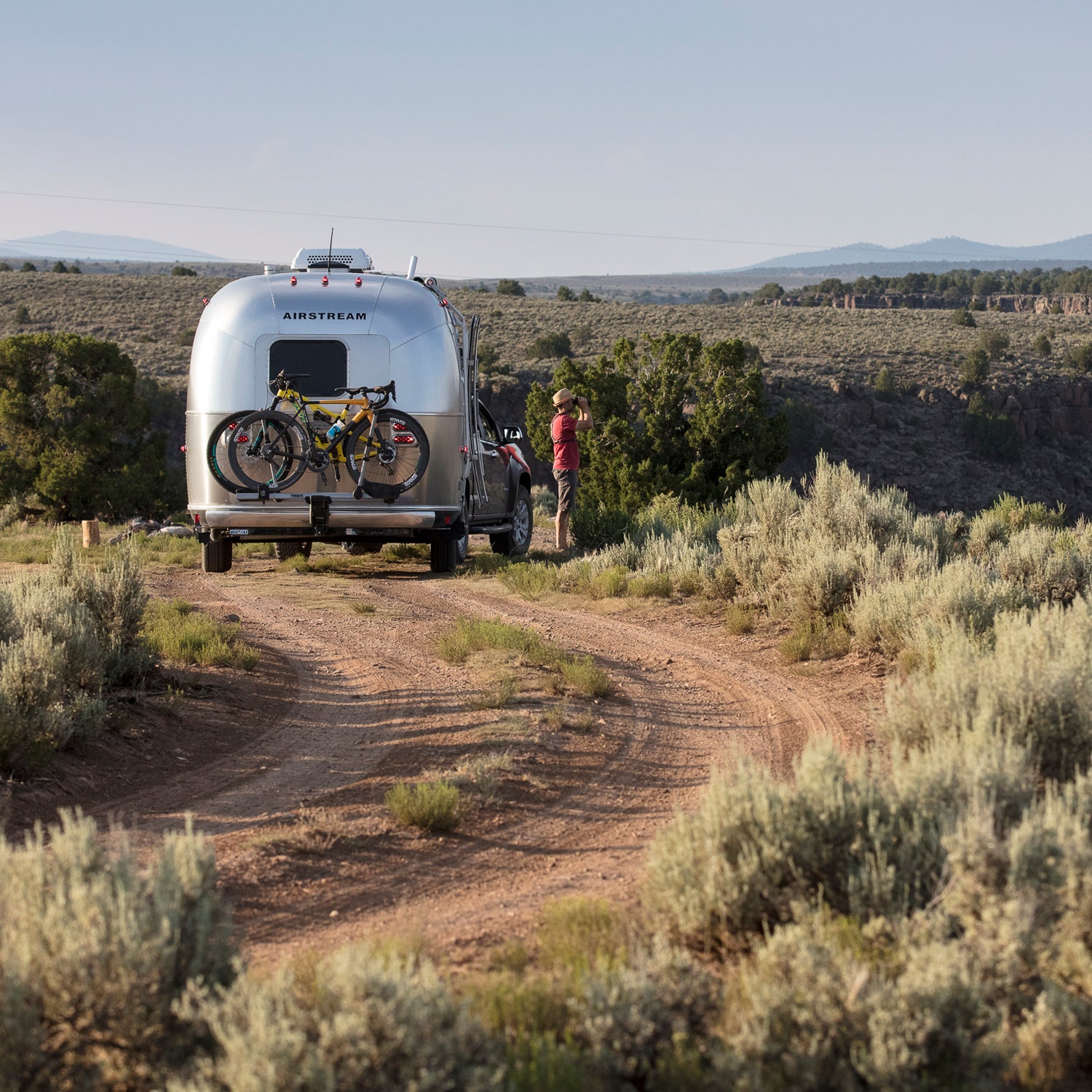On a secluded, arrow-straight stretch of northern New Mexico U.S. Route 285, beneath the volcanic arch of San Antonio mountain, a sign appeared within the last two months: . When we saw the new marquee, Jen and I nearly swerved off the road with surprise. We discussed the sign for a few miles, wondered if we’d misconstrued it, and flipped a U-turn—Artemis, the Airstream, and all—to go back for a better look.
Since moving to Santa Fe from Denver over a decade ago, we have driven this lonely stretch hundreds of times, back and forth to visit family and friends in Colorado. I love this part of the state, its scraggly, empty, finch-green sage prairies punctuated by San Antonio’s jade slopes of gamble oak and ponderosa. Never, though, did I realize it was a national monument.
If you haven’t heard, 27 national monuments are under reconsideration. I’ve visited many of them over the years—Aztec Ruins, Bandelier, Bears Ears, Canyon de Chelly, El Malpais, El Moro, Giant Sequoia, Gila Cliff Dwellings, Grand Staircase-Escalante, Hovenweep, Kasha-Katuwe, Marianas Trench, Organ Pipe Cactus, Organ Mountains, Petroglyph, Rainbow Bridge, Vermillion Cliffs, and White Sands—and I’ve still taken them for granted. But seeing that sign, and knowing that this was a place so close to home that I didn’t know existed, made me realize I can’t take them for granted forever. Jen and I couldn’t stop that morning, but we vowed to return.
It turns out, President Obama only named Rio Grande del Norte a national monument on March 25, 2013. The land earned its designation for the mighty laceration of the Rio Grande Gorge, which cuts the surrounding flatlands like a jagged lightning strike, as well as for the countless petroglyphs, pit houses, and stone tools leftover from ancient civilizations. The area is also home to numerous hot springs, and a profusion of wildlife, including elk, deer, pronghorn, and bear. At 242,455 acres, it’s a significant swathe of wilderness, though it’s barely a raft on the sea of New Mexico open space—just 0.3 percent of the state’s total area.
Rio Grande is one of the national monuments , with an eye toward trimming or revocation. For me, the thought that these lands, which were set aside for me just a few years ago, might be diminished or rescinded before I even get a chance to use them, is kind of like inheriting an Airstream from an old eccentric aunt, then having it totaled before you step inside. The Department of Interior to help determine the monuments future up through July 10.
A few weeks after we saw that sign, Jen and I rolled up to Rio Grande on a smoky, sizzling Wednesday afternoon for a few nights of early summer camping. At the visitor center, the ranger on duty and the volunteer ranger walked us through the map of the monument, lingering over details of the place. Yes, the campgrounds are great but the two recommended a few spots for dry camping with better views. No, they didn’t recommend dragging Artemis up the switchbacks at Taos Junction, much less at the farther north Wild Rivers crossing. Yes, Rocky Mountain bighorns had recently been reintroduced to the gorge from the high country, though the likelihood of spotting them was low.
“Are you worried that the monument might be reduced or defunded under the review?” I wondered.
“Phphphphtttt! We think about that every day,” the volunteer told me. “It would be a travesty. But people wouldn’t even know what they are losing. So yeah, we worry about it.” Then she added, “I can say that because I’m a volunteer.”
“Do the new signs on 285 have anything to do with the reconsideration of the monument?”
“I can’t say for certain. They’ve been putting up a lot of kiosks,” she said. “But it’s certainly not a bad time to get the word out. We’re popular, but it never hurts to be more popular.”
From the visitor center, we dragged Artemis up County Road 567 and, despite the rangers’ warnings, made it to the top okay, though barely. Then we barreled across open-country to a spot that Jen had spotted on Google Earth. Amid a sea of sagebrush, the land seemed to crack open, and we perched our camp overlooking a thousand-foot drop to the Rio Grande River. We sipped bourbon on the overlook, and, skepticism aside, I spotted a bighorn while glassing. The night was warm and silent, and mule deer picked their way through the green understory when we set up our coffee perch the next morning. It was a peaceful and perfect camp.
I didn’t realize until I visited, but I had been to this place before. I’ve mountain biked the far rim, levitated over a section of the gorge in a balloon, and soaked in the hot springs more than once with friends. I just never realized that place was a national monument. Perhaps that lack of recognition is these wild lands’ problem right now. If more people plowed through the sagebrush ocean, spied ungulates hidden in the greenery, and camped under a spray of ivory stars knitted in a black quilt firmament, as we did, it’s difficult to imagine that support for them wouldn’t swell.
What I know for certain is that Rio Grande del Norte is quiet, open, stunning high desert. I don’t care about the politics of it. I just hope that we’ll be able to pull Artemis up to that rim for years to come and sleep under dark, silent skies.


